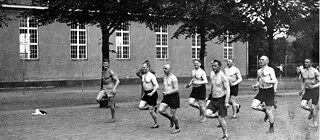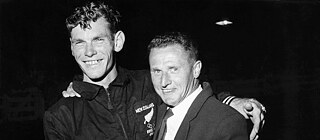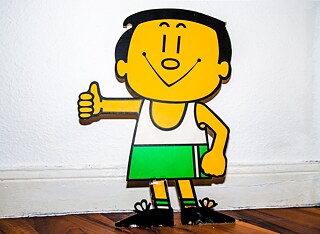Jogging
Shoes, Sex, and the Freedom of Just Taking Off Running

It would be hard to find a sport that is older, more egalitarian, or more popular: a tribute to endurance running.
By Alina Schwermer
Jogging is perhaps the most underappreciated sports movement ever. 6.3 million Germans frequently go for a run, and another 17 million jog at least occasionally. Yet what would they have us believe is the Germans’ favorite sport? Right, it is meant to be soccer. But only around 3.5 million Germans over the age of 14 say they kick the ball around often. Just watching does not really count.
Which means running has been rather sensationally successful, and drastically underreported. The only time it gets much coverage in Germany might be during the Berlin Marathon. Jogging has a rather hard time of it in the media: It is not really about victory or defeat. The amateur runner is really only competing against herself. And it does not need the backing of powerful associations or necessitate arenas. One of the largest mass sport movements in post-war history. And, incidentally, also pretty big business.
Running Has Been Around Forever

A sarcastic person might point out: since we began calling it jogging. And that, in fact, changed a few things.
For a long time, running was the occupation of just a few, often ambitious men – popular sport as we know it today did not exist. With the triumph of jogging, ordinary people began engaging in mass, self-organized recreational sports. And not inside athletic facilities, but in full view of everyone on the streets and in the parks of the city. Both were a revolution at the end of the 1960s.

“Run With Ease, Without a Wheeze”
It took an apostle to turn jogging into big business though: American Bill Bowerman, who trained with Lydiard and published his own jogging guidebook in the US in 1967. This simply written primer sold jogging as a healthy sport anyone could do and became a bestseller. Conveniently, as a co-founder of the Nike company, Bowerman was also promoting his own interests. Nike released the first running shoe one year later.

And what might have happened without strong industry backing as well? Running shoes for the average person proved to be a gold mine. Nike and Adidas discovered an industry that would earn 20 billion dollars annually in the 21st century. Jogging has remained more than a flash-in-the-pan fad because the profit margin is simply greater than, say, bowling. Companies created an entire industry around it. The marathon went from being the ambition of a few crazies to the “Mount Everest for everyone.”
The Boom of Fitness Studios
And yet jogging is also a grassroots movement, in part because it has always fit so well with the zeitgeist. It promises more than just exercise. From the very beginning, it was seen as a way to switch off, to relax, to calm the mind. Something that, by the way, the German Sport University Cologne scientifically proved again just recently: The brain blocks out superfluous stimuli when jogging, making it an exercise in meditation. This is a very attractive idea in a society being crushed under the ever-increasing demands of wage labor.
Moreover, jogging, as a self-organized, free activity, always offered flexible narratives. During the sexual revolution in the late 1960s, magazines praised it as a tried-and-true way to improve one’s sex life. Yes, really. In the 1970s, jogging was also considered spiritual self-exploration. And medical ethicist Isabella Marcinski describes the rise of the fitness ideal in the eighties as a symptom of neoliberalism: a healthy body was associated with performance, discipline, youthfulness, success. The middle class physically distinguished itself from the “lazy” poor. “Stagnation, lack of agility, even laziness are socially frowned upon.” Then came the boom in fitness studios, where jogging now takes place on a treadmill. And CEOs in Silicon Valley boast of their morning running routines.
Nevertheless, the grassroots potential is still there. In 2019, the International Institute for Race Medicine found that for the first time, more women than men were participating in races worldwide. Few sports are as egalitarian. The institute also noted a global shift: In marathons, for example, finishing times are steadily getting slower. Participants are primarily interested in the experience, and many less athletic people join in. Meanwhile, the true fanatics are switching to more extreme challenges: Ultra runs and Ironman races are booming. Society’s belief in increased performance and fit bodies remains unbroken.
But if that is just a bit too much for you, you can simply do what people have been doing for half a century: Walk out of the front door and just take off running. No registration, no membership fee, no mental pressure, and no specific goal for how far your feet should carry you.